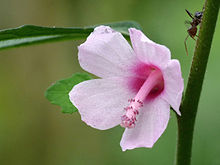
Urena lobata

Urena lobata, commonly known as Caesarweed or Congo jute, is an annual, variable, erect, ascendant undershrub measuring up to 0.5 meters (1.6 ft) to 2.5 meters (8.2 ft) tall. The stems are covered with minute, star-like hairs and often tinged purple. Considered a weed, it is widely distributed in the tropics, including in Brazil and Southeast Asia. Each individual plant grows as a single stalk that freely sends out bushy stems. The leaf shape is palmately lobed (having lobes that spread out like fingers on a hand). Like the stem, the leaves also have tiny hairs. Flowers of the plant are pink-violet and grow one centimeter in width. The fruit is also hairy and may stick to clothing or fur. The plant can invade areas of ecological disturbance as well as eroded places, crop plantations, and pastures. Caesarweed is considered an invasive species in the state of Florida, United States. There it grows as an annual in most areas except for in the southern region, where it may live perennially. In Florida, the plant has been reported to grow rapidly from 0.5 meters (1.6 ft) to 2 meters (6.6 ft) by the end of its first year of growth. The plant is not competitive in tall grasses or under canopies. The University of Florida's pest management procedures for handling this plant include prevention through treating before seeds form and maneuvering vehicles to avoid driving near Caesarweed, mulching and shading to prevent germination, and the use of chemical herbicides. In the Encyclopédie ou Dictionnaire raisonné des sciences, des arts et des métiers (Vol. 1 , p. 191), Denis Diderot's article about the plant is listed under the heading Aguaxima, a common Portuguese name for the plant. The entry is notable not for its one-sentence description of its subject ('Aguaxima, a plant growing in Brazil and on the islands of South America.'), but for Diderot's editorializing that follows it. Frustrated by the uselessness of such a poor article, he muses about what audience it could possibly serve. His conclusion is a succinct critique of the popular assumption that encyclopedias should be measured according to their breadth or comprehensiveness rather than quality.
